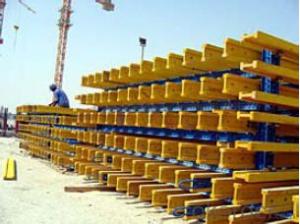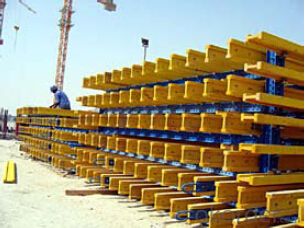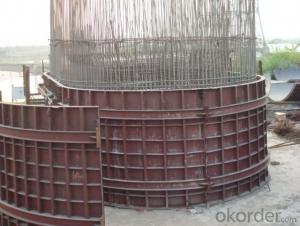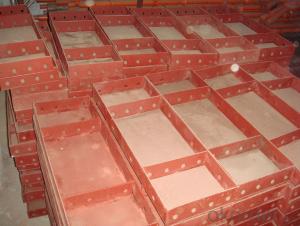Timber-beam Plywood Formwork For building Construction
- Loading Port:
- Tianjin
- Payment Terms:
- TT OR LC
- Min Order Qty:
- 50 m²
- Supply Capability:
- 1000 m²/month
OKorder Service Pledge
Quality Product, Order Online Tracking, Timely Delivery
OKorder Financial Service
Credit Rating, Credit Services, Credit Purchasing
You Might Also Like
Plywood --- make perfect concrete surface
WISA-Form Birch is a coated special plywood using in the formwork systems where high
requirements are set on the concrete surface and the times of reuses.
With CNBM timber beam & WISA plywood, the formwork is low weight but high load capacity, it is
widely used in construction.
Characteristics:
◆ Component with high standardization.
◆ Assembling in site, flexible application.
◆ Light weight, easy transportation and storage.
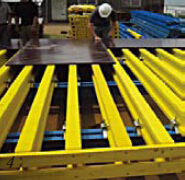

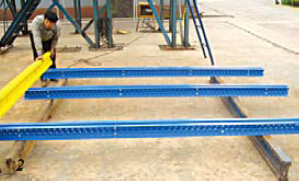
- Q: What are some of the components of the combined steel template, what role?
- Two, the main equipment1, mechanical equipment, drill, grinding wheel cutting machine, according to the circular machine, electric wrenches and welding equipment, etc..2, the main tool hammer, iron ruler, steel ruler, wrench, wire brush, brush. Drums, crowbar, screwdriver, theodolite, level. Tower ruler.
- Q: What are the common safety precautions when working with steel formwork in high winds?
- When working with steel formwork in high winds, there are several common safety precautions that should be followed to ensure the safety of workers and the integrity of the formwork. 1. Secure the formwork: It is essential to properly secure the steel formwork to prevent it from being blown away by strong winds. This can be achieved by using appropriate anchoring methods such as tie-downs, braces, or clamps. Adequate bracing should be installed at regular intervals to provide additional stability. 2. Regular inspections: Regular inspections of the formwork should be conducted before, during, and after high wind events. This includes checking for any signs of damage or weakness in the formwork structure, loose connections, or compromised anchoring. Any issues identified should be addressed promptly to prevent accidents or further damage. 3. Reinforce the formwork: In areas with high wind activity, it may be necessary to reinforce the steel formwork to withstand the stronger forces. This can be done by adding additional support beams, cross-bracing, or wind-resistant features to the structure. The reinforcement should be designed and implemented by a qualified engineer to ensure its effectiveness. 4. Provide personal protective equipment (PPE): Workers should be provided with appropriate personal protective equipment to protect them from potential hazards during high wind conditions. This may include safety helmets, goggles, gloves, and high-visibility clothing to enhance visibility for other workers and equipment operators. 5. Monitor weather conditions: Regular monitoring of weather conditions is crucial when working with steel formwork in high winds. If there are predictions or signs of strong winds, work should be temporarily suspended until the wind speeds decrease to safe levels. It is important to have a reliable weather monitoring system in place to stay informed about changing weather conditions. 6. Training and communication: All workers involved in working with steel formwork should receive proper training on the safety precautions and procedures to follow during high wind situations. Clear communication channels should be established to ensure that workers are aware of any changes in weather conditions or safety protocols. By following these common safety precautions, the risks associated with working with steel formwork in high winds can be minimized, ensuring the well-being of workers and the successful completion of the construction project.
- Q: Are there any environmental considerations when using steel formwork?
- Yes, there are several environmental considerations when using steel formwork. Firstly, steel production is energy-intensive and contributes to greenhouse gas emissions. However, steel formwork can be reused multiple times, reducing the need for new materials and minimizing waste generation. Additionally, proper disposal and recycling of steel formwork at the end of its lifespan is important to reduce environmental impact. Overall, while steel formwork has certain environmental drawbacks, its reusability and recyclability make it a more sustainable option compared to other formwork materials.
- Q: Can steel formwork be used for precast concrete beams?
- Yes, steel formwork can be used for precast concrete beams. Steel formwork is commonly used in precast concrete construction due to its durability, strength, and ability to create complex shapes and designs. It provides a stable and precise mold for pouring and shaping the concrete, ensuring the quality and accuracy of the precast concrete beams.
- Q: Can steel formwork be used for precast concrete stairs?
- Yes, steel formwork can be used for precast concrete stairs. Steel formwork is a suitable choice for constructing precast concrete stairs due to its durability, strength, and ability to create complex shapes. It provides a strong and stable mold for pouring and shaping the concrete, resulting in high-quality and precise precast concrete stairs.
- Q: What are the different types of accessories used in steel formwork systems?
- There are several types of accessories that are commonly used in steel formwork systems. These accessories are designed to provide support, stability, and ease of use during the construction process. One type of accessory is the formwork prop, also known as a shore or post. These props are adjustable in height and are used to support the formwork panels or beams. They provide vertical support and help distribute the weight of the concrete. Another accessory commonly used in steel formwork systems is the formwork beam. These beams are used to support the formwork panels horizontally and provide additional strength and stability. They can be made of steel or aluminum, depending on the specific requirements of the project. Formwork clamps are another important accessory used in steel formwork systems. These clamps are used to connect the formwork panels or beams together, ensuring that they are securely held in place. They come in various sizes and designs to accommodate different formwork configurations. Tie rods and wing nuts are also commonly used accessories in steel formwork systems. These are used to secure the formwork panels tightly and prevent any gaps or leaks. The tie rods are inserted through holes in the panels and tightened using wing nuts, creating a strong and secure connection. Additionally, formwork brackets and supports are used to reinforce the formwork system and provide additional stability. These accessories are typically attached to the structure or scaffolding to hold the formwork in place. Other accessories that may be used in steel formwork systems include formwork corners, wedges, and spacers. These accessories help to ensure accurate and precise formwork placement and alignment. Overall, the different types of accessories used in steel formwork systems serve various purposes such as support, connection, reinforcement, and alignment. They are essential in creating a strong and reliable formwork system that can withstand the pressures and forces exerted during the concrete pouring process.
- Q: Can steel formwork be used for circular columns?
- Yes, steel formwork can be used for circular columns. Steel formwork is a versatile and flexible option that can be easily adjusted to different shapes and sizes, including circular columns. Its strength and durability make it suitable for creating precise and stable concrete structures, even with complex geometries like circular columns.
- Q: How does steel formwork handle high concrete pressures?
- Steel formwork is able to handle high concrete pressures due to its inherent strength and rigidity. Steel is a durable and robust material that has the ability to withstand significant loads and pressures without deforming or collapsing. It ensures that the formwork structure remains stable and secure, even when subjected to the high pressures exerted by the poured concrete. This makes steel formwork an ideal choice for construction projects where high concrete pressures are anticipated.
- Q: How does steel formwork contribute to the overall safety of the construction process?
- Steel formwork contributes to the overall safety of the construction process by providing a sturdy and stable structure for concrete pouring. Its strength and durability minimize the risk of accidents caused by collapsing or shifting formwork. Additionally, steel formwork is fire-resistant, reducing the likelihood of fire hazards on the construction site. Its reusable nature also reduces waste and potential environmental hazards, ensuring a safer working environment for construction workers.
- Q: How does steel formwork affect the overall construction site dust control?
- Steel formwork can significantly improve dust control on a construction site. Its solid structure and smooth surface minimize the release of dust particles, reducing the potential for airborne dust. Additionally, steel formwork can be easily cleaned and maintained, further limiting dust accumulation. Overall, using steel formwork helps create a cleaner and healthier environment for workers and minimizes the need for additional dust control measures.
Send your message to us
Timber-beam Plywood Formwork For building Construction
- Loading Port:
- Tianjin
- Payment Terms:
- TT OR LC
- Min Order Qty:
- 50 m²
- Supply Capability:
- 1000 m²/month
OKorder Service Pledge
Quality Product, Order Online Tracking, Timely Delivery
OKorder Financial Service
Credit Rating, Credit Services, Credit Purchasing
Similar products
Hot products
Hot Searches
Related keywords

